Maximum Marks: 80
Time allowed: Two and half hours
Answers to this Paper must be written on the paper provided separately.
You will not be allowed to write during first 15 minutes.
This time is to be spent in reading the question paper.
The time given at the head of this Paper is the time allowed for writing the answers.
Section-A
(Attempt all questions from this Section.)
Question 1
Choose one correct answer to the questions from the given options:
(i) Loss of water as droplets from the hydathodes is called:
(a) Transpiration
(b) Bleeding
(c) Guttation
(d) Evaporation
View
Solution
(ii) Synthesis phase in the cell cycle is called so, because of the synthesis of more:
(a) Glucose
(b) Proteins
(c) RNA
(d) DNA
View
Solution
(iii) While playing with his friends, Peter inserted a stick into his ear. He lost his
hearing due to the rupture of:
(a) Ear drum
(b) Pericardium
(c) Cornea
(d) Pinna
View
Solution
(iv) The prime source of Chloro fluorocarbons is:
(a) Vehicular emissions
(b) Refrigeration equipment
(c) Sewage
(d) Effuents
View
Solution
(v) Oxygenated blood to heart is supplied by:
(a) Hepatic artery
(b) Coronary artery
(c) Renal artery
(d) Pulmonary artery
View
Solution
(vi) Assertion (A): There is frequent urination in summer than in winter.
Reason (R): In summer we lose a lot of water as sweat, so the kidneys reabsorb
more water. Hence, urine formed is less in summer than in winter.
(a) Both A and R are True
(b) Both A and R are False
(c) A is True and R is False
(d) A is False and R is True
View
Solution
(vii) The age restrictions for marriage for boys and girls by law in India is:
(a) Boys 18 years, Girls 21 years
(b) Boys 17 years, Girls 16 years
(c) Boys 21 years, Girls 18 years
(d) Boys 20 years, Girls 17 years
View
Solution
(viii) Hari is fond of watching the fish in an aquarium. So, he set up an aquarium in his
house. Along with a number of fresh water fish, he also placed a clown fish which
is a salt water fish. After few hours, the clown fish was found dead and floating on
water. This was due to:
(a) Endosmosis
(b) Exosmosis
(c) Osmoregulation
(d) Excretion
View
Solution
(ix) The solvent used for dissolving chlorophyll while testing a leaf for starch is:
(a) Sodium hydroxide
(b) Lime water
(c) Water
(d) Ethyl alcohol
View
Solution
(x) The structure related to storage and maturation of sperms in a human male is:
(a) Epididymis
(b) Epidermis
(c) Epithelium
(d) Endothelium
View
Solution
(xi) A sequence of DNA has 200 nitrogenous base pairs, of which 100 are ThymineAdenine pairs. What is the number
of Cytosine-Guanine pairs in this sequence:
(a) 50
(b) 200
(c) 100
(d) 25
View
Solution
(xii) The stress hormone in plants which functions during a drought is:
(a) Auxins
(b) Abscisic acid
(c) Ethylene
(d) Cytokinins
View
Solution
(xiii) Compressed natural gas (CNG) is proposed to be a better alternative to fossil fuel
Which of the following reasons makes it a better alternative?
P. Combustion leaves little or no residue
Q. Absence of Carbon in CNG
R. Easily available
(a) Only P
(b) Only Q
(c) Only P and R
(d) Only Q and R
View
Solution
(xiv) The ground substance present in chloroplast is:
(a) Stoma
(b) Stroma
(c) Grana
(d) Thylakoids
View
Solution
(xv) Lata wanted to cross the road. She looked on either side of the road and then
walked across to the other side of the road.
Which of the following is / are involved in the process described above?
1. Cerebrum
2. Cerebellum
3. Skeletal muscles
4. Medulla Oblongata
(a) Only 3
(b) Only 1 and 3
(c) Only 1, 3 and 4
(d) Only 1, 2 and 3
View
Solution
Question 2
(i) Name the following:
(a) The respiratory pigment in Erythrocytes.
(b) The tissue that transports manufactured food from the leaves to all the parts of
the plant.
(c) The type of gene, which in the presence of a contrasting allele, is not expressed.
(d) The duct which carries urine from the urinary bladder to outside the body.
(e) The collective term for the protective membranes of the brain.
(ii) Arrange and rewrite the terms in each group in the correct order so as to be in a
logical sequence beginning with the term that is underlined.
(a) Snake, Grass, Frog, Grasshopper
(b) Cochlea, Malleus, Pinna, Stapes
(c) Fibrin, Thrombin, Fibrinogen, Platelets
(d) Endodermis, Cortex, Xylem, Epidermis
(e) Embryo, Foetus, Blastocyst, Morula
(iii) Fill in the blanks with suitable words:
The technical term for short sightedness is (a) __________. This defect is caused
because the eyeball is (b) __________ from front to back or the lens is too
(c) __________. It can be corrected by using a suitable (d) __________ lens. The
power of the lens is mentioned in (e) __________.
(iv) Choose the odd one out from the following terms and name the category to which
the others belong:
(a) Newspapers, Vegetable peels, Electric bulbs, Animal excreta
(b) Renal pelvis, Renal artery, Renal Cortex, Renal medulla
(c) Urochrome, Urea, Keratin, Uric acid
(d) Oval window, Cochlea, Auditory canal, Round window
(e) ADH, TSH, ACTH, NAD
(v) Match the items given in Column I with the most appropriate ones in Column II and
rewrite the correct matching pairs.
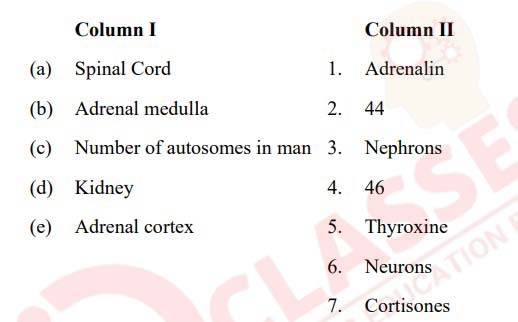
View
Solution
Section-B
(Attempt any four questions from this Section.)
Question 3
(i) The gene of red hair is recessive to the gene for black hair. What will be the hair
colour of a person if he inherits a gene for red hair from his mother and a gene for
black hair from his father?
(ii) State Mendel’s Law of Dominance.
(iii) What are Homologous chromosomes?
(iv) Differentiate between Phenotype and Genotype.
(v) Draw a neat, labelled diagram of a duplicated chromosome.
View
Solution
Section-B
(Attempt any four questions from this Section.)
Question 4
(i) Mention the exact location of Corpus callosum.
(ii) What are the two hormones secreted by Corpus luteum?
(iii) Differentiate between Menarche and Menopause.
(iv) What is the significance of placenta in the growth of foetus?
(v) Draw a neat, labelled diagram of a human gamete that has the sex chromosome.Y
View
Solution
Question 5
(i) Explain the term – Photsynthesis.
(ii) Write the overall chemical equation of Photosynthesis.
(iii) A potted plant having variegated leaves was exposed to sunlight for 3 hours. One of
the leaves was plucked and tested for starch. What will be your observation after the
starch test?
(iv) The initial food prepared by a green plant is A, which is later converted to food B by
polymerization. Name food A and food B.
(v) Study the diagram given below and answer the questions that follow:
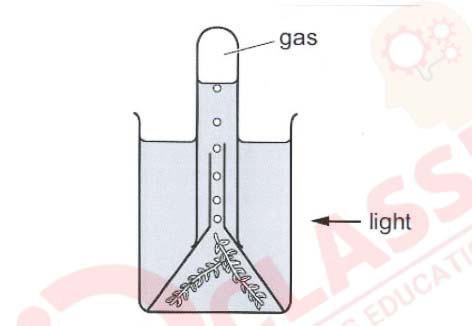
(a) Name the gas released when the setup was placed in sunlight.
(b) Give an example of an aquatic plant that can be used in the above experiment.
(c) What will happen if a pinch of Sodium bicarbonate is added to the water?
View
Solution
Question 6
(i) Give the exact location of genes.
(ii) Differentiate between Karyokinesis and Cytokinesis.
(iii) Mention two significant features of the stage Anaphase during Mitosis.
(iv) How many daughter cells are formed at the end of Mitosis and Meiosis?
(v) Study the diagram given below and answer the questions that follow:
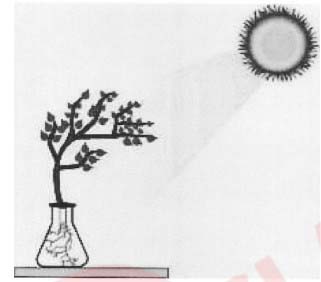
(a) Name the phenomenon depicted by the shoot in the above diagram.
(b) Which plant hormone plays an important role in the above movement?
(c) Name one stimulus which gives a positive response for the roots but negative
response for the shoot.
View
Solution
Question 7
(i) What is the scientific name for man?
(ii) What are vestigial organs? Give one example.
(iii) State two structural differences between an artery and vein.
(iv) Mention any two features of the Cro-Magnon man.
(v) Study the picture given below and answer the questions that follow:
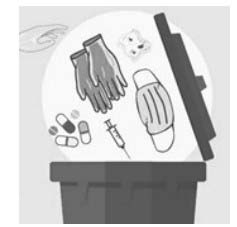
(a) Name the category of waste that is being disposed.
(b) Give an example of such a waste.
(c) Are they hazardous to humans and animals? Give a suitable reason to justify
your answer
View
Solution
Question 8
(i) Define – Osmosis.
(ii) Name the two sensory cells in retina meant for light adaptation.
(iii) Mention one function each for – Cerebrum and Cerebellum.
(iv) State any two objectives of Swachh Bharat Abhiyan.
(v) Given below is the diagram of human blood smear. Answer the questions that follow:
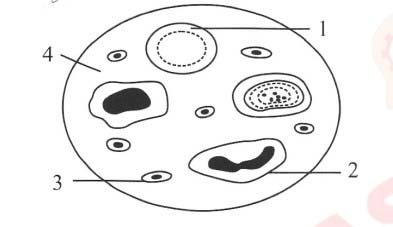
(a) Mention one structural difference between 1 and 2.
(b) What is the function of part 3?
(c) Name the part labelled 4
View
Solution




